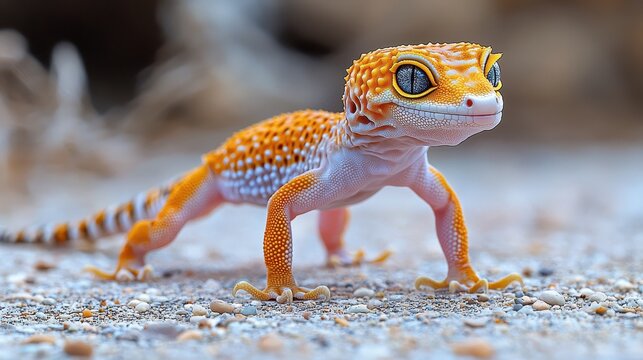Geckos are fascinating reptiles known for their agile movements and distinctive appearance. However, many people wonder, is a gecko oviparous or viviparous? Gecko reproductive methods are quite interesting, and some species exhibit rare reproductive traits. This article will provide a detailed analysis of gecko reproduction, exploring their reproductive behavior, biological characteristics, and answering common questions about how geckos reproduce.

Geckos belong to the reptile family, and most species are oviparous, meaning they reproduce by laying eggs. However, some species of geckos are ovoviviparous, a relatively uncommon trait among reptiles. To understand whether a gecko is oviparous or viviparous, let’s first distinguish between these two methods of reproduction.
Female geckos lay fertilized eggs outside their body.
The fertilized eggs develop externally until they hatch into young geckos.
The majority of geckos, such as leopard geckos and Asian house geckos, are oviparous.
Fertilized eggs remain inside the mother’s body until the embryos develop fully.
The developing embryos rely on the nutrients from the egg yolk, not the mother’s body.
After the eggs hatch internally, the mother gives birth to live young.
For example, New Zealand green geckos (Naultinus spp.) are ovoviviparous.
Most geckos follow an oviparous reproductive process, where the female lays eggs and leaves them to develop independently. Below are the typical steps in the reproduction of oviparous geckos:
Geckos typically breed during the warm spring and summer months.
Male geckos attract females by emitting calls and performing body displays.
After successful courtship, the female accepts the male for mating.
Female geckos lay eggs approximately 3–6 weeks after mating, usually in clutches of 1–2 eggs.
They search for safe, hidden places, such as crevices, leaves, or walls, to lay their eggs to protect them from predators.
Gecko eggs can have hard or soft shells, depending on the species.
The incubation period ranges from 40 to 90 days, depending on environmental conditions such as temperature and humidity.
When ready, baby geckos break through the eggshell and emerge as fully independent young.
Hatchlings have all the necessary survival features, including limbs, tails, and sharp eyesight.
Though rare, some geckos exhibit ovoviviparity, a reproductive method that helps them adapt to specific environments.
Ovoviviparous geckos are often found in colder or isolated habitats, such as New Zealand forests.
In such environments, internal egg development helps shield the embryos from external temperature fluctuations.
The fertilized eggs develop inside the mother’s body, relying solely on the yolk sac for nutrients.
When the embryos mature, they hatch internally, and the mother “gives birth” to live young.
Advantages: Ovoviviparity increases reproductive success by protecting the embryos from harsh environmental conditions.
Challenges: The mother undergoes significant physiological stress during the gestation period and requires additional nutrition to sustain her health.
The reproductive method of geckos is closely related to their environment:
Tropical and Subtropical Regions: Oviparous geckos thrive in warm, humid conditions that support external egg development.
Temperate and Cold Regions: Ovoviviparous geckos carry their eggs internally to protect the embryos from cold temperatures and predators.
Ovoviviparous geckos have a higher survival rate for their offspring since the eggs are better protected within the mother’s body compared to oviparous geckos, whose eggs are vulnerable to predators.
To avoid predation during reproduction, some geckos exhibit unique defense behaviors:
Certain geckos shed their tails as a distraction to escape predators.
Some species choose hidden or high-up nesting sites for egg-laying to increase the chances of survival.
| Characteristic | Oviparous Geckos | Ovoviviparous Geckos |
|---|---|---|
| Reproductive Method | Lay eggs externally | Retain eggs until live birth |
| Nutrient Source for Embryos | Egg yolk only | Egg yolk only |
| Common Species | Leopard gecko, house gecko | New Zealand green gecko |
| Typical Habitat | Tropical and subtropical regions | Cooler or isolated regions |
| Reproductive Advantage | Short reproductive cycle, more eggs | Embryo protection and higher survival rate |
| Challenges | Eggs are vulnerable to predators | High energy demand on the mother |
Possible Causes:
Inadequate environmental temperature or humidity.
Poor diet or underlying health issues.
Solutions:
Ensure the gecko’s enclosure has the correct temperature and humidity.
Provide a balanced diet with calcium and vitamins to support reproductive health.
Gecko eggs typically hatch within 40–90 days, depending on the species and environmental conditions.
In rare cases, female geckos may eat their eggs due to stress or nutrient deficiency. Proper nutrition and a stress-free environment can prevent this behavior.
Most geckos are oviparous, meaning they lay eggs, but some species are ovoviviparous and give birth to live young. Whether a gecko is oviparous or viviparous depends on its species and habitat. Both reproductive methods demonstrate the remarkable adaptability of geckos to their environment. Understanding gecko reproduction helps us better care for these fascinating reptiles and appreciate their unique survival strategies. Whether in the wild or captivity, providing the right environment is crucial to ensuring successful reproduction and the overall health of geckos.
animal tags: gecko
We created this article in conjunction with AI technology, then made sure it was fact-checked and edited by a Animals Top editor.